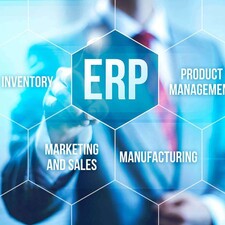Blog
5 Keys to a Successful ERP Data Migration

Summary
The challenges of ERP data migration can be mitigated through sound business processes.
Who in your company can recite from memory the threading crest for the hundreds of screws supplied by all of your parts vendors? Does this person also know the purchase price, procurement lead times, and current quantity of screws in inventory? In most companies, no such person exists.
Most likely, the data is maintained in multiple electronic and paper-based systems and scattered across company departments.
Every company has a unique set of customers and manufacturing systems, whether they produce a common product for a broad market or more specialized products for a niche industry. In each case, their legacy ERP systems will reflect their company's heritage, market needs, and manufacturing environment.
the goal of the new system is to bring all of this data together in a cohesive system to enable streamlined communication across employees, departments, and partners
Legacy systems for enterprise management have often been built over years or decades. These systems may consist of thousands or tens of thousands of data objects divided across separate systems. While some systems will be well documented, other systems will be maintained only in the heads of those employees who use them. For companies that are migrating to a new ERP, the goal of the new system is to bring all of this data together in a cohesive system to enable streamlined communication across employees, departments, and partners.
Read on for the 5 keys to success when planning for your ERP data migration:

1. The ERP data champion
A key element of success or failure of an ERP data migration is the presence of an internal data champion. This person spearheads data capture and helps to transition large amounts of data from old legacy systems to the new ERP. The data champion is typically a long-time company employee who knows the current databases inside and out and can communicate effectively across departments to formulate data collection processes. The role of the data champion involves pushing forward on the project until every piece of data has been successfully imported into the new ERP.
the data champion knows the background of the company's legacy systems and can navigate across the organization
As a company insider, the data champion knows the background of the company's legacy systems and can navigate across the organization to track down the domain knowledge experts who know the details. The data champion's job will start with reviewing existing systems and interviewing employees to determine the source record for each type of data. After organizing the collected data into structured worksheets with required fields and formats for every data object, the data champion will engage in importing that data into the ERP, testing and validation, and training the workforce in the use of the new system.
2. Organizing legacy ERP data
In an ERP data migration, each department will be responsible for collecting and evaluating the data that's most important to their function.
To examine the case of the finance department, the personnel of that department would work with the data champion to categorize their data objects into a structured format. The top level data objects might include cash accounts, deposits, accounts receivable, accounts payable, inventory, and fixed assets. Each of these larger objects contains a hierarchy of individual data objects. For example, fixed assets may include property, plant, and equipment accounts, each of which has data related to depreciation formulas, depreciation value, and net book value. Many of these data objects will have validation rules, for example the data might be required in numeric format and not text. For numeric values, there may be a specified number of decimal places and minimum and maximum permitted values. If a data object is intended to be a unique identifier, rules will exist to ensure that duplicate values are not allowed.
The output of this exercise will be a set of documents that defines every data object that is stored and used by the department. These documents become part of the company's data protocol.

Interested in how to write a smart RFP for your next ERP system?
Download the ebook, Writing a Better ERP RFP
3. Process management and ERP data migration tools
One of the ways to stay organized throughout your data migration is by using data protocol worksheets. The protocol worksheets span the entire enterprise and contain the source of truth for all data. Each data protocol worksheet addresses the individual data objects for each functional area.
In addition, the data protocol enforces the business processes for conducting the migration. The worksheets mandate task completion for every data object, including reviews and approvals by multiple parties in order to finalize the documentation.
In many cases, the data protocol will serve as a guide for copying source data from the legacy system into an import tool. This data will be normalized into a structured format that can be easily inserted into the new ERP. Thus the worksheets become a critical element in business process management for the migration project.

4. Import of legacy data into an ERP
Specialized software tools assist with the data import into the ERP. These tools run validation logic during the import that can automatically flag any data that does not adhere to the predetermined rules of the data protocol. The flagged data is queued for human review to determine if the data can be manipulated into an acceptable format or require further investigation to correct errors in the data.
While few people would claim an ERP migration is easy, the use of good processes and tools can ensure the data migration is executed smoothly and quickly
One example of flagged data might be a duplicate product identifier; the identifier was intended to be unique in the system but some previous mistake introduced a duplicative value into the legacy system. Resolution of the duplication could occur by merging the two data values, modifying one into something different, or deleting one of the duplicate values. The reverse situation can also occur where two data fields are listed as unique in the system, but they are actually the same value that was entered differently by two different people. These types of normalization problems might be rectified by the data champion or they may require intervention by a data domain expert from a specific department.
With abas ERP, these data migration tools used for importing legacy data are available to your business throughout the implementation process and even afterward, so that you are not dependent on the ERP consultants to do this work for you.
5. Simulation, training, and rollout
Taking a phased approach to the ERP data migration helps catch problems and fix them early. It can also minimize the size of the staff involved during the earlier stages of the deployment which often require iterations and fine tuning to get the system to an optimized state. In the initial step, functional managers – the key users – may be selected to run extensive tests and simulate actual business processes in the system. The data champion works with these experts, and by using the data protocol, is able to import data in a phased approach.
For example, payment terms may get imported into the live database well in advance, as these terms will likely not change during the implementation. However, major data objects like the Master File for parts will go through multiple stages of validation, and new custom variables may be needed based on the results of the simulations. This means that the data migration file will continue to grow over the course of the implementation.
While few people would claim an ERP installation is easy, the use of good processes and tools can ensure the ERP data migration is executed smoothly and quickly. And the end result should be well worth it since the goal is an efficient and well running enterprise.
Want to know how abas can help you achieve your ERP goals? Contact us today.


